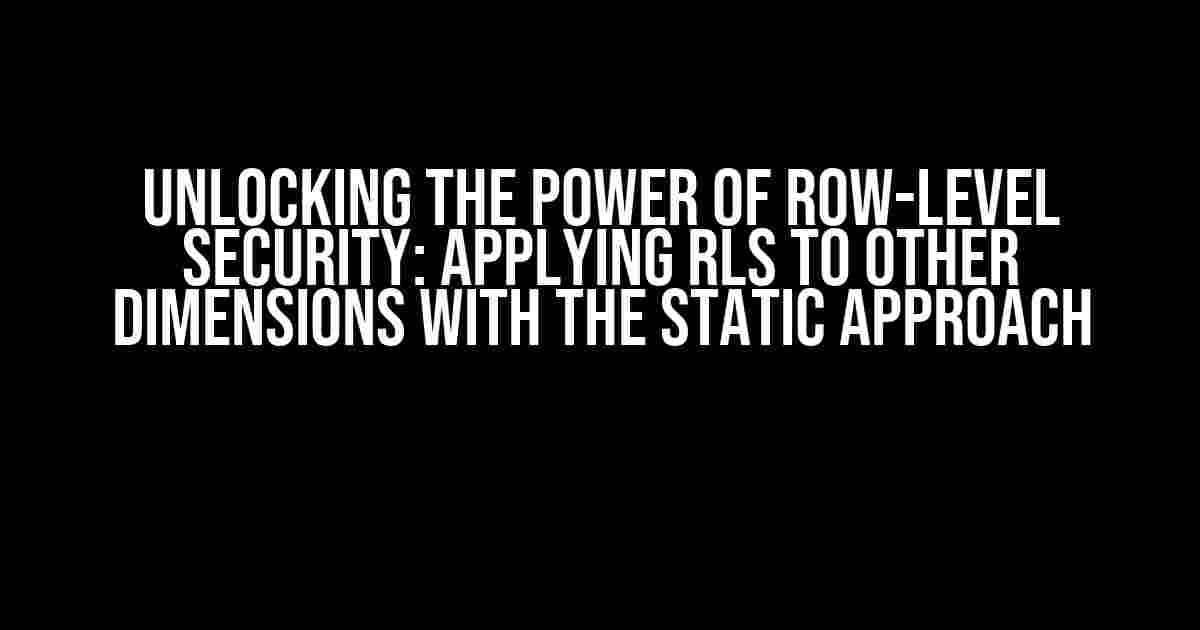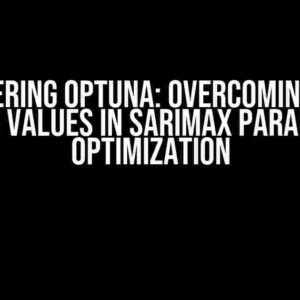Row-Level Security (RLS) is a powerful feature in databases that enables fine-grained access control to data. When using the static RLS approach, you can apply RLS to other dimensions beyond the traditional row-level security. In this article, we’ll delve into the world of RLS and explore how to apply it to other dimensions, enabling you to take your data security to the next level.
What is Row-Level Security (RLS)?
Before we dive into the meat of this article, let’s take a step back and understand what Row-Level Security (RLS) is. RLS is a security feature that restricts access to data based on the user’s identity, role, or permissions. It allows you to control which rows of data a user can view, edit, or delete. With RLS, you can create policies that filter out sensitive data, ensuring that only authorized users can access it.
The Static RLS Approach
The static RLS approach involves defining a fixed set of rules that determine which rows a user can access. This approach is ideal for scenarios where the security requirements are well-defined and don’t change frequently. In this article, we’ll focus on applying the static RLS approach to other dimensions.
Applying RLS to Other Dimensions
When applying RLS to other dimensions, you need to consider the following scenarios:
- Column-Level Security: This involves restricting access to specific columns within a table. For example, you might want to hide sensitive data like credit card numbers or passwords.
- Table-Level Security: This involves restricting access to entire tables or groups of tables. For instance, you might want to restrict access to a table containing sensitive data, such as employee salaries.
- Schema-Level Security: This involves restricting access to entire schemas or databases. For example, you might want to restrict access to a schema containing confidential business data.
Column-Level Security
To apply RLS to column-level security, you need to create a security policy that filters out sensitive columns. Here’s an example using T-SQL:
CREATE SECURITY POLICY column_level_security
ADD FILTER PREDICATE (column_name = 'public_column')
TO table_name(columns);
In this example, the security policy filters out all columns except for the “public_column” column. This ensures that users can only access the public column and not the sensitive columns.
Table-Level Security
To apply RLS to table-level security, you need to create a security policy that restricts access to entire tables. Here’s an example using T-SQL:
CREATE SECURITY POLICY table_level_security
ADD FILTER PREDICATE (table_name = 'public_table')
TO schema_name.tables;
In this example, the security policy filters out all tables except for the “public_table” table. This ensures that users can only access the public table and not the sensitive tables.
Schema-Level Security
To apply RLS to schema-level security, you need to create a security policy that restricts access to entire schemas. Here’s an example using T-SQL:
CREATE SECURITY POLICY schema_level_security
ADD FILTER PREDICATE (schema_name = 'public_schema')
TO database_name.schemas;
In this example, the security policy filters out all schemas except for the “public_schema” schema. This ensures that users can only access the public schema and not the sensitive schemas.
Best Practices for Applying RLS to Other Dimensions
When applying RLS to other dimensions, it’s essential to follow best practices to ensure the security and integrity of your data. Here are some tips:
- Define Clear Security Requirements: Clearly define the security requirements for each dimension. This will help you create policies that are tailored to your specific needs.
- Use Strong Predicate Logic: Use strong predicate logic to define your security policies. This will ensure that your policies are secure and effective.
- Test Your Policies Thoroughly: Test your policies thoroughly to ensure they’re working as expected. This will help you identify any gaps or vulnerabilities in your security.
- Monitor and Audit Your Security: Monitor and audit your security regularly to ensure that it’s effective and up-to-date.
Common Challenges and Solutions
When applying RLS to other dimensions, you may encounter some common challenges. Here are some solutions to help you overcome them:
| Challenge | Solution |
|---|---|
| Complex Security Requirements | Break down complex security requirements into smaller, manageable policies. |
| Performance Issues | Optimize your security policies for performance by using efficient predicate logic and indexing. |
| Security Policy Conflicts | Use conflict resolution mechanisms to resolve policy conflicts and ensure that the most restrictive policy applies. |
Conclusion
In conclusion, applying RLS to other dimensions using the static approach is a powerful way to enhance data security and control. By following the best practices and solutions outlined in this article, you can create effective security policies that protect your data from unauthorized access. Remember to define clear security requirements, use strong predicate logic, test your policies thoroughly, and monitor and audit your security regularly.
By taking your data security to the next level, you can ensure the integrity and confidentiality of your data, and give your organization the confidence to operate in a rapidly changing world.
Further Reading
Want to learn more about Row-Level Security and its applications? Check out these resources:
Happy learning, and remember to stay secure!
Frequently Asked Question
Need help applying RLS to other dimensions using the static RLS approach? We’ve got you covered!
Can I apply RLS to multiple dimensions simultaneously?
Yes, you can apply RLS to multiple dimensions at once. Simply create a separate RLS policy for each dimension and combine them using the AND operator. This way, you can ensure that all conditions are met before applying RLS.
How do I handle hierarchical dimensions when applying RLS?
When dealing with hierarchical dimensions, you can create separate RLS policies for each level of the hierarchy. For example, if you have a dimension like “Region” with sub-dimensions like “Country” and “City”, create separate policies for each level.
Can I use RLS with aggregate dimensions?
Yes, you can apply RLS to aggregate dimensions, but you’ll need to define the aggregation rules first. For instance, if you have a dimension like “Sales” with an aggregate function like SUM, define the aggregation rule before applying RLS.
How do I handle dynamic dimensions when applying RLS?
For dynamic dimensions, create a separate RLS policy for each possible value of the dimension. You can also use parameterized RLS policies to make the process more efficient.
Are there any performance considerations when applying RLS to multiple dimensions?
Yes, applying RLS to multiple dimensions can impact performance. To mitigate this, use indexing, caching, and optimize your RLS policies to reduce the number of calculations and improve query performance.


